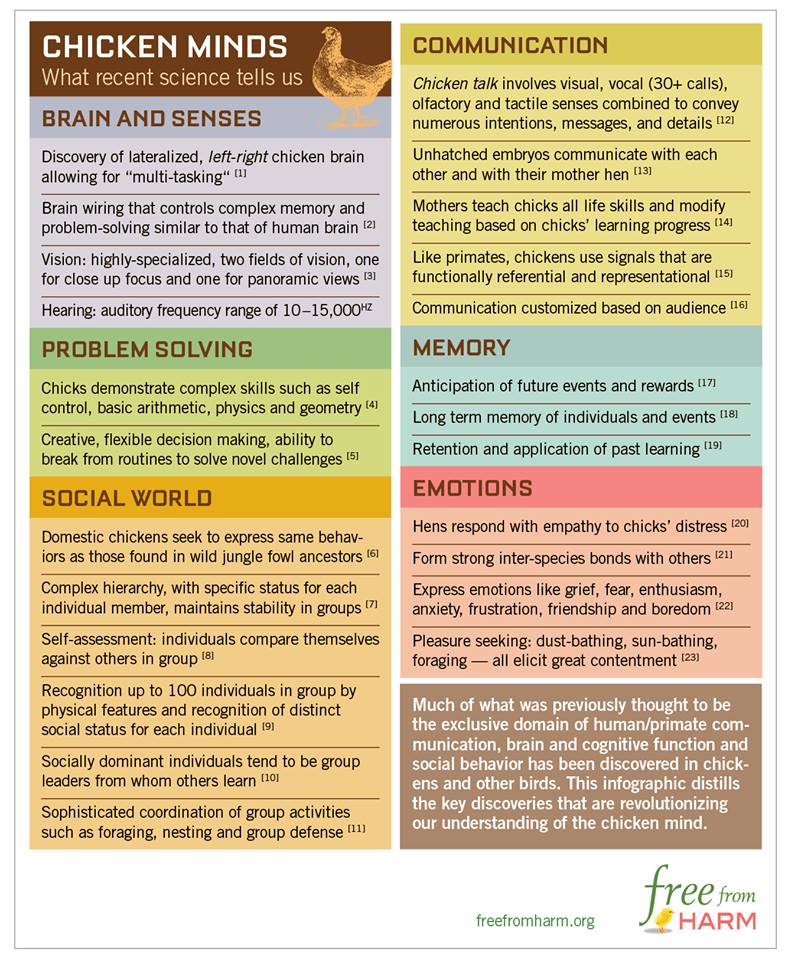Courage — for chickens … (02/06/14)
What we’ve learned about the avian brain and social behavior in just the last 10 years contradicts hundreds of years of misinformed, primitive views about chickens & other birds. Much of what was previously thought to be the exclusive domain of human / primate communication, consciousness and cognitive function is now being regularly documented in chickens and other birds.
The Truth of the matter is now clear:
HOW GOOD THEY TASTE IS NO LONGER AN EXCUSE!
Even with relatively little hands-on experience raising chickens, I too have readily witnessed most of these characteristics in chickens … Chickens are remarkably intelligent, highly social, just as sentient as you or I, and most certainly suffer just as immensely as we do when imprisoned or abused or killed.
So please, Please, PLEASE … Won’t you stop eating my Friends?
Thank you.

P.S. For those who might be interested, here are the scientific sources for this particular infographic:
1. Rogers, Lesley J., The Development of Brain and Behaviour in the Chicken. Wallingford, Oxfordshire, 1995. p. 231.
2. Smith, Colin, Bird brain? Birds and humans have similar brain wiring. Science Daily (Imperial College London), 2012
3. Marian Stamp Dawkins, What Are Birds Looking At? Head Movements and Eye Use in Chickens, Animal Behaviour, IXIII (2002) pp. 991–8.
4. Rugani, Rosa, Regolin , Lucia, Vallortigara, Giorgio, Imprinted numbers: newborn chicks’ sensitivity to number vs. continuous extent of objects they have been reared with, Developmental Science, September 2010, Volume 13, Issue 5, pages 790–797
5. Smith, Carolynn L. and Johnson, Jane, The Chicken Challenge – What Contemporary Studies Of Fowl Mean For Science And Ethics, Between the Species, Vol. 15 (2012) > Iss. 1, p. 84
6. G. McBride et al, ‘The Social Organization and Behavior of the Feral Domestic Fowl’, Animal Behavior Monographs, n (1969), p.25
7. Wood-Gush and Duncan, ‘Behavioral Observations in Domestic Fowl,’ p.255
8. Smith, Carolynn L. and Johnson, Jane, The Chicken Challenge – What Contemporary Studies Of Fowl Mean For Science And Ethics, Between the Species, Vol. 15 (2012) > Iss. 1, p. 89
9. Specter M, “The Extremist,” The New Yorker, April 14, 2003, p. 64.
10. Smith, Carolynn L. and Johnson, Jane, The Chicken Challenge – What Contemporary Studies Of Fowl Mean For Science And Ethics, Between the Species, Vol. 15 (2012) > Iss. 1, p. 82
11. Ibid, p. 86
12. Annie Potts, Chicken. London: Reaktion Books, 2012. p. 44
13. Rogers, Lesley J., The Development of Brain and Behaviour in the Chicken. Wallingford, Oxfordshire, 1995. p. 48
14. Smith, Colin, Bird brain? Birds and humans have similar brain wiring. Science Daily (Imperial College London), 2012, p.82
15. Ibid, p. 76
16. D.G. Griffin, Animal Minds: Beyond Cognition to Consciousness (Chicago, 2001), p. 173
17. Beaugrand, J. P., M. E. Hogue, and P. C. Lague. 1997. “Coherent Use of Information by Hens Assisting to the Victory or Defeat of Their Former Dominant by a Stranger: A Case of Transitive Inference?” In Processus cognitifs et ajustement écologique, edited by Société Francaise pour
l’Étude du Comportement Animal, 131–137. Toulouse, France: Presses de l’Université Paul Sabatier.
18. Dunbar, R. I. M., and Susanne Shultz. 2007. “Evolution in the
Social Brain.” Science 317: 1344-1347.
19. Nicol, Christine. 2006. “How Animals Learn from Each Other.” Applied Animal Behavior Science 100: 58-63.
20. ‘Avian maternal response to chick distress’, J L Edgar, J C Lowe, E S Paul, C J Nicol, published online ahead of print Proceedings of the Royal Society B, 9 March 2011.
21. Davis, Karen PhD, The Social Life of Chickens, Columbia University Press, 2012
22. Annie Potts, Chicken. London: Reaktion Books, 2012, p. 46–52
23. Ibid.




 ;
;